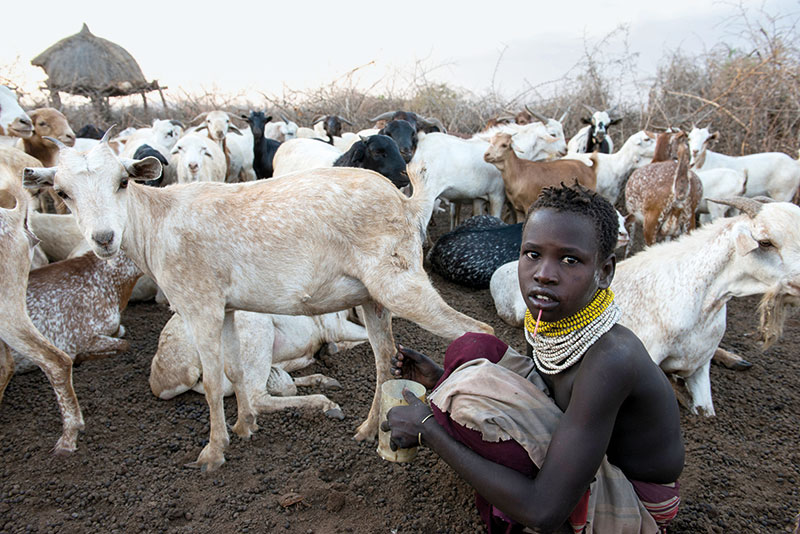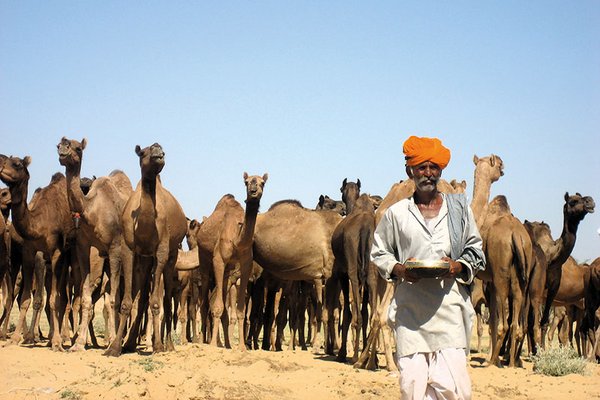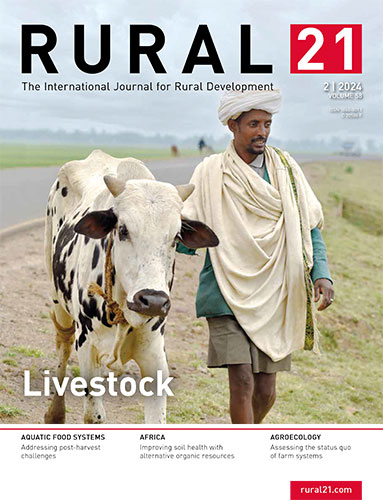 Download this article in magazine layout
Download this article in magazine layout
- Share this article
- Subscribe to our newsletter
Learning from pastoralists
“Planetary Boundaries” is a concept that defines the environmental limits humanity can safely operate in without risking interfering with the regulatory processes of the planet. A team of scientists led by Swedish scientist Johan Rockström identified nine processes that keep the Earth in balance. They relate to land use change, ocean acidification, climate change, freshwater use, biosphere integrity, biochemical flows, novel entities, and others. It is a rather complex framework, but is much more specific and practice-oriented than “Sustainability”, which has become almost meaningless given its universal application without concrete definition. In the livestock sector, sustainability is largely being gauged by greenhouse gas (GHG) emissions per product unit, which ignores impacts on key facets of planetary boundaries, such as biodiversity, land use change, freshwater use, biochemical flows, etc. Livestock certainly plays a huge role in whether human activities remain within planetary boundaries. Since 1961, the earliest year for which the United Nations Food and Agriculture Organization (FAO) has recorded data, the world’s livestock numbers have increased exponentially, vastly outpacing human population growth. In the 60 years between 1961 and 2021, poultry populations increased by 700 per cent, goat and camel numbers tripled, pig numbers grew by 250 per cent, and buffalo numbers doubled. The growth of poultry and pig populations has only been possible because of the global trade in livestock feed that enables industrial livestock production units to be set up without regard for the local availability of feed. This is now grown in the form of monocultures of soy, corn and alfalfa in one part of the world (the Americas) and transported to other continents such as Europe, the Middle East and Asia, whose livestock population growth could otherwise not be supported. This expansion leads to deforestation in the Amazon (and elsewhere) and associated biodiversity loss, and goes along with an increased danger of novel diseases emerging.
At the receiving end, the monocultures of animals in industrial settings may produce animal protein cheaply, but they are accompanied by a multitude of negative impacts on the environment in terms of soil, air, and water pollution, by the use of antibiotics and ensuing antimicrobial resistance, and of course, by a serious lack of animal welfare. Apart from that there is the issue of GHG emissions, which currently seem to be the dominant focus of livestock research.
Despite the enormous impact that farm animals have on the Earth’s regulatory processes, as first collated in its 2006 “Livestock’s Long Shadow” report, the FAO states that livestock output needs to double by 2050. At the same time, there is an enormous backlash against animal farming, with young people being attracted by veganism, and corporate interests utilising this scenario to develop imitation livestock products of questionable environmental impact and nutritional value while pushing for the total elimination of livestock from the planet by 2040. Several UN agencies have joined this bandwagon. Recently, to reduce nitrogen emissions from manure and fertiliser, the Dutch government has come forward with a plan to close more than 10,000 farms and reduce the size of 17,000 more, a move that has understandably led to wide-spread protests.
An ecological necessity for a functioning planet
But a world without livestock is unrealistic from the perspective of food security and agroecology. We must realise that only one third of the world’s agricultural land is classified as arable, i.e. suited for crop cultivation, while in roughly two thirds of it, food can only be produced by means of livestock converting the existing inedible plant mass into edible animal protein and fat. In addition, even in fertile areas where crops can easily be grown, livestock is necessary to uphold the circulation of nutrients into the soil and decrease the amount of chemical fertiliser. In fact, the separation of crops and livestock is ecologically disastrous, and they need to be re-integrated as much as possible to recycle nutrients.
Rather than aiming to eliminate livestock, the challenge is to transform the livestock sector so that it is in balance with the Earth's resources and buffers against climate change rather than accelerating it. In this respect, we can learn much from pastoralists who specialise in keeping diverse types of livestock, such as reindeer in the Arctic, yaks in Asia’s high-altitude zones, Bactrian camels and dromedaries in the deserts of Asia and Africa, cattle, sheep and goats in the semi-arid steppes and savannahs of Africa, and llamas and alpacas in the Andes in South America. We tend to think of pastoralism as a minor and marginal phenomenon, but it covers a far greater share of the globe than sedentary farming. A galaxy of herding cultures manages around 40 per cent of the world’s landmass, an area about three times larger than that cultivated with crops (see also World map of pastoralists).
A solar-powered, biodiversity-conserving way of food production
For pastoralists, the starting point of their considerations and planning is the availability of plant biomass – be it natural vegetation or crop aftermath – that is available within walking distance of their animals. The rationale of their system is to deploy herds to harvest these resources, whether they are in high altitudes, thinly dispersed in remote areas or growing on roadsides, or on empty plots in urban areas. To this end they require animals that are physically fit and can walk over long distances, that thrive on whatever grows in a particular region, withstand inclement weather and can slow down their metabolism to cope with seasonal shortages. Their breeds retain characteristics of their wild ancestors by being tough and resilient. But unlike their untamed predecessors, they tolerate and even relish proximity to humans. In herding societies, people and animals are bound together in a relationship of mutual dependence and trust.
Pastoralists adhere to planetary boundaries by utilising only what is already available and would otherwise go to waste, either provided by nature or left over by farmers. They do not spend energy on growing feed, and animals walk to their forage. Their system is basically solar-powered. It is fossil fuel-free and does not add any CO2 to the atmosphere. Whereas crop farmers destroy biodiversity by replacing native vegetation with monocultures and routinely deploying chemical fertilisers, pesticides and other -cides, pastoralists do none of this, directly converting a multitude of foraging plants into human-edible protein. Herding mimics the ecological role of wild herbivores by upcycling biomass for consumption by predators and carnivores, and by recycling nutrients into the soil. In view of the fact that the planet’s wild fauna has been reduced by more than 90 per cent, some experts think that herded animals are essential to uphold the functionality of the planet and contribute to its cooling.
There is no doubt that herding animals is absolutely the most natural way of food production that exists, which is of enormous relevance at this point in human history. The need to reduce emissions from agriculture has been agreed upon as a priority during the COP 28 (Conference of the Parties to the UN Framework Convention on Climate Change) in late 2023 in Dubai. In FAO’s own words, we need agrifood system solutions that build resilience, adapt to climate change, and reduce emissions while safeguarding biodiversity and ensuring food security for all. No other agrifood system fulfils these requirements as well as pastoralism.
The first step for keeping livestock within planetary boundaries is a paradigm change
In animal science, sedentary livestock keeping is the default model. The focus of the discipline has been on improving efficiency in terms of feed to food conversion. At a superficial level, this concept makes sense since it seeks to minimise the use of resources, is most economical, and results in smaller amounts of GHG emissions per unit of product. Unfortunately, it is also reductive and ignores the crucial aspect of recyclability of resources as well as the other positive and negative impacts that animal farming has on biodiversity, soil, water, air, livelihoods, public health, and animal welfare.
If we use “efficiency” as the only yardstick for evaluating livestock systems, then concentrated animal feed operations come out on top despite their multitude of negative impacts, while animal welfare-friendly grazing systems that sequester carbon and enhance biodiversity fall behind. In our current scenario, we can no longer afford this simplification and must articulate a new theoretical framework for livestock development that takes the complexity of the situation into account and figures in all the positive and negative aspects or trade-offs of farming animals. Only then will we be able to design systems that stay within planetary boundaries. This new paradigm must consider animal well-being, use of fossil fuels, impact on biodiversity, soil, water, air pollution, the nutritional content of animal-sourced food and, especially, livelihood impacts, and public health.
The current ‘efficiency paradigm’ has contributed to and provided scientific justification for the rise of industrial animal farming. It has played into the hands of the oligopoly of corporate giants that currently control the flow of feed and animal genetic resources across the globe. It has disadvantaged the estimated 400 million to one billion of herders and small-scale livestock keepers who use local livestock to optimally utilise the limited resources in their respective environments and convert them into high-value protein, and whose livelihoods depend on livestock.
Currently, GHG emissions are the dominating lens through which animal scientists view livestock, and much research effort is devoted to measuring and reducing methane emissions, even in poorer countries who have historically not contributed to global warming and where grazing animals are the backbone of rural economies. Of course, ruminant livestock, be it sheep, goats, cattle, camels, the South American camelids, yaks, buffaloes or even reindeer, all do emit methane. But so do giraffes, elephants, buffaloes and all the many antelopes that roam around in Africa’s savannah, or their relatives in Asian steppes. As Spanish researcher Pablo Manzano has pointed out, if we were to remove livestock from grasslands and drylands, wild ruminants and termites would move into the vacated space, making this basically a zero-sum game in terms of methane emissions.
Lessons from pastoralists

In herding societies, people and animals are bound together in a relationship of mutual dependence and trust.
Photo: Jörg Böthling
It may seem far-fetched to look to pastoralists for guidance when designing livestock systems for the future, considering the lack of space and the hectic scramble and grab for the remaining open land. Nevertheless, we can extract certain principles from the art and science of pastoralism that we should integrate into other systems of livestock production as much as possible to make them more environment- and animal-friendly.
Movement. The first principle is to keep livestock moving. This has two main benefits. It keeps animals healthy and saves fossil fuels. And it is in line with nature. Movement is what distinguishes animals from plants. While plants can directly convert sunlight into energy by means of photosynthesis, animals do not have that facility. To live and reproduce, they must move to the plants to obtain energy. Unfortunately, over the last century or so we have reversed this design principle and keep animals in fixed locations while moving plants to them. We need to reverse this and focus on making best use of the biomass that is locally available, either naturally or as crop by-product, without expending fossil fuels on growing it.
Multifunctionality. Livestock breeding has become too specialised, concentrating on one product only, i.e. milk, meat or eggs, which involves a huge waste of resources in the form of male animals that have no purpose. Pastoralists have animals that are multi-functional and provide a range of products, such as meat, milk, manure and skins as well as ecological services. The principle of multifunctionality should not only be applied to animals but also to land use. Livestock production can easily be integrated with green energy, with landscape enhancement, crop, forest management, recreational uses, etc.
Diversity. Thirdly, we need a diversity of animals that fit varied eco-systems and are robust and resistant to the spread of diseases. We need to counter the ongoing loss of animal genetic resources and get policy-makers to understand that high yielding Holstein-Friesian cows are not a panacea for rural development, but often turn into a burden and debt-trap. Locally adapted animals are easier and cheaper to manage.
Circularity. Fourthly, we need to design circular livestock systems in which nutrients are recycled and manure is an asset that upholds soil fertility rather than representing a toxic mass that pollutes groundwater and water bodies, besides fouling the air. Re-integration of crops and animals is called for, and crop and animal scientists must interact and not work in isolation.
Quality. Fifthly, there needs to be more focus on the quality of livestock products rather than on their quantity, an aspect which is currently ignored. The products from animals grazing or browsing on biodiverse vegetation are vastly different from those fed on concentrate and standardised diets. When animals ingest feed rich in phytochemical substances, this has impact not only on the animals but also on the humans who eat them.
Decolonising animal science
Governments almost everywhere have sought to stop herding, blamed it for environmental destruction, and declared it dead. This is to a big extent, the consequence of the colonial era when agricultural concepts of settled farming that originated in the temperate climates of the colonisers were instituted in countries with significant populations of mobile pastoralists, for instance in India. But herding is still very much alive; although struggling, it is showing enormous resilience under human-made adverse conditions as well as climate change. And it is experiencing a change in fortune. Development agencies seek to revive mobile livestock keeping, beginning to extract lessons from pastoralism for coping with climate change. Transhumance, the movement between summer grazing in the highlands and winter pastures in the lowlands, has been declared UNESCO intangible cultural heritage in more than ten different countries. In the USA, regenerative and conservation grazing are rapidly gaining steam. We need a new way to look at livestock that recognises mobility as a key feature of ecological and animal welfare-friendly animal farming!
Ilse Köhler-Rollefson is a German veterinarian who has been based in India for the last 35 years. She is co-founder of the League for Pastoral Peoples and consults widely for FAO and other UN agencies.
Contact: ilse.koehlerroll@googlemail.com
This article is based on the book “Hoofprints on the Land”, published by the author in January 2023.
References:
Johan Rockström et al: Planetary boundaries: Guiding human development on a changing planet. https://www.science.org/doi/10.1126/science.1259855
Anna Holligan (BBC News): Why Dutch farmers are protesting over emissions cuts.
https://www.bbc.com/news/world-europe-62335287




